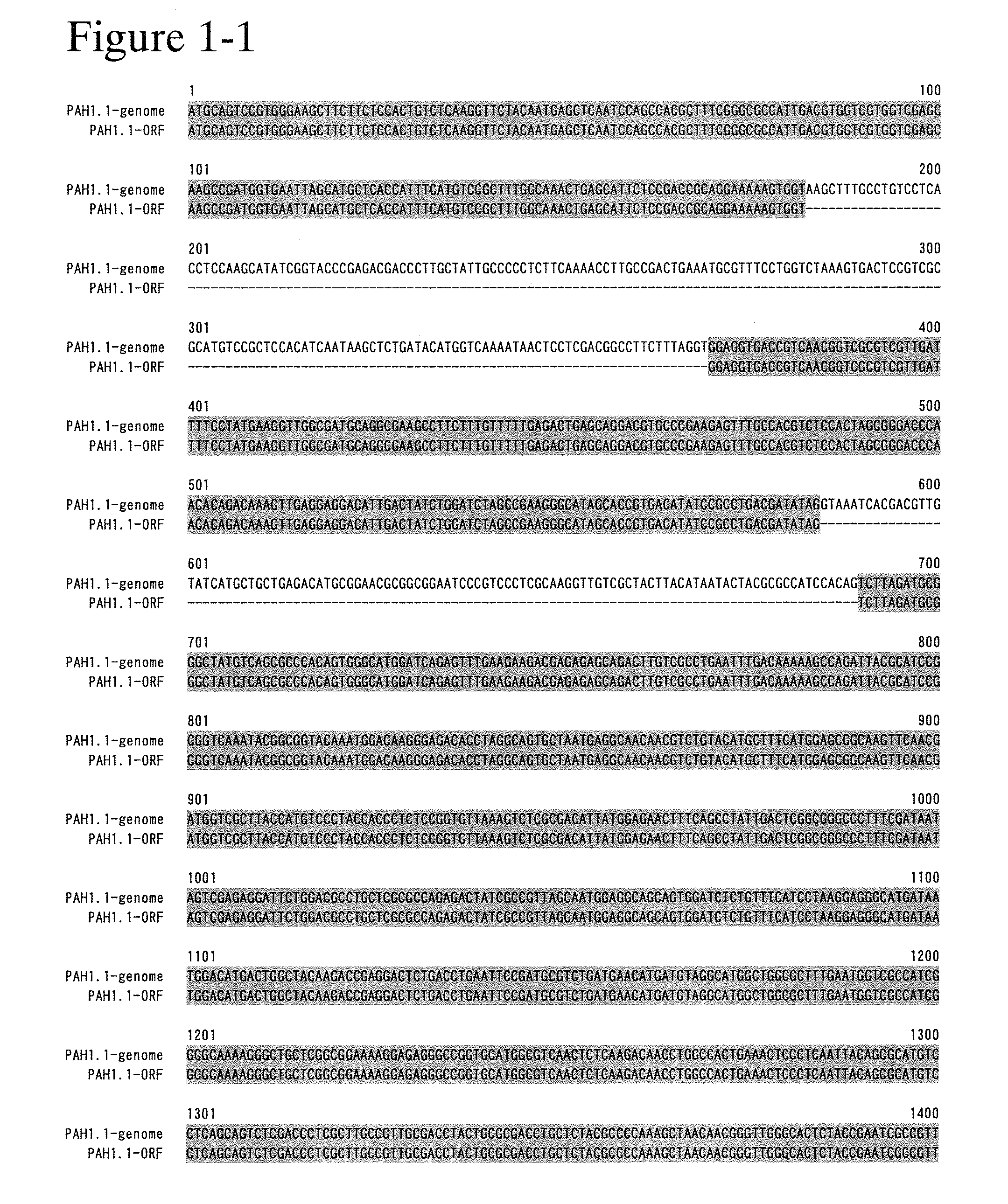Phosphatidic acid phosphatase gene and use thereof
a technology of phosphatidic acid phosphatase and gene, which is applied in the field of new phosphatidic acid phosphatase gene, can solve the problems of small amount of polyunsaturated fatty acids contained in animal organs, insufficient supply and insufficient extraction and isolation of polyunsaturated fatty acids from animal organs, so as to enhance the ability to produce fatty acids and reserve lipids, and enhance the productivity of polyunsaturated
- Summary
- Abstract
- Description
- Claims
- Application Information
AI Technical Summary
Benefits of technology
Problems solved by technology
Method used
Image
Examples
example 1
Genomic Analysis of M. alpina
[0276]M. alpina strain 1S-4 was inoculated into 100 mL of a GY2:1 medium (2% glucose, 1% yeast extract, pH 6.0) and was shake-cultured at 28° C. for 2 days. The cells were collected by filtration and genomic DNA was prepared by using DNeasy (QIAGEN).
[0277]The nucleotide sequence of the genome DNA was determined using a Roche 454 GS FLX Standard. On this occasion, the nucleotide of a fragment library was sequenced in two runs, and the nucleotide of a mate pair library was sequenced in three runs. The resulting nucleotide sequences were assembled to obtain 300 supercontigs.
example 2
Synthesis of cDNA and Construction of cDNA Library
[0278]M. alpina strain 1S-4 was inoculated into 100 mL of a medium (1.8% glucose, 1% yeast extract, pH 6.0) and was shake-cultured at 28° C. for 4 days. The cells were collected by filtration, and total RNA was prepared by a guanidine hydrochloride / CsCl method.
[0279]From the total RNA, cDNA was synthesized by reverse transcription with SuperScript II RT (Invitrogen) using a random hexamer. In addition, from the total RNA, poly(A)+ RNA was purified using an Oligotex-dT30mRNA Purification Kit (Takara Bio Inc.). A cDNA library was constructed using a ZAP-cDNA GigapackIII Gold Cloning Kit (STRATAGENE).
example 3
Search for Homolog of S. cerevisiae-Derived PAH1
[0280]The amino acid sequence of a gene having the PAP activity of Saccharomyces cerevisiae, PAH1 (YMR165C) (may be also referred to as ScPAH1 in the specification), was subjected to tblastn analysis against M. alpina strain 1S-4 genome nucleotide sequences. As a result, supercontigs including the sequences set forth in SEQ ID NO: 5 and SEQ ID NO: 10 gave a hit. The gene relating to SEQ ID NO: 5 was named MaPAH1.1, and the gene relating to SEQ ID NO: 10 was named MaPAH1.2.
PUM
| Property | Measurement | Unit |
|---|---|---|
| TG | aaaaa | aaaaa |
| temperature | aaaaa | aaaaa |
| pH | aaaaa | aaaaa |
Abstract
Description
Claims
Application Information
 Login to View More
Login to View More - R&D
- Intellectual Property
- Life Sciences
- Materials
- Tech Scout
- Unparalleled Data Quality
- Higher Quality Content
- 60% Fewer Hallucinations
Browse by: Latest US Patents, China's latest patents, Technical Efficacy Thesaurus, Application Domain, Technology Topic, Popular Technical Reports.
© 2025 PatSnap. All rights reserved.Legal|Privacy policy|Modern Slavery Act Transparency Statement|Sitemap|About US| Contact US: help@patsnap.com



